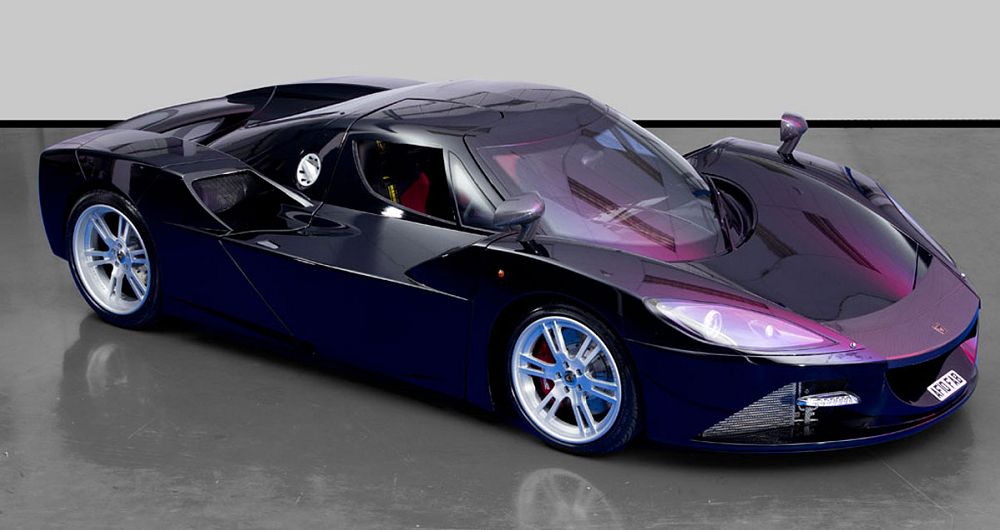The dawn of the 2010s marked a fascinating period in British automotive history. While established manufacturers focused on mass-market evolution, a bold wave of boutique supercar makers emerged from unexpected corners of the UK. These ambitious ventures weren’t just building cars — they were rewriting the rules of what was possible with enough passion and engineering prowess.
In this landscape of automotive innovation, Arash Motor Company made their most audacious move yet. The AF-10 emerged not as just another supercar, but as a testament to the potential of small-scale British engineering excellence. With its full carbon fiber construction and modified American heart, it represented a unique fusion of traditional craftsmanship and cutting-edge technology.
Engineering Marvel: The Heart of AF-10
The AF-10’s powerplant tells a story of innovative engineering through strategic collaboration. At its core sits a 7.0-liter V8 engine, derived from the GM LS7 but extensively modified to meet Arash’s exacting standards. The result is an impressive 550 horsepower delivered at 6,200 rpm, backed by 644 Nm of torque peaking at 4,800 rpm.
The engine’s natural aspiration might seem conservative in an era of forced induction, but this choice reveals a deeper engineering philosophy. As renowned engine specialist James Mitchell notes: “The AF-10’s power delivery is remarkably linear and predictable. This makes it not just fast, but genuinely usable in real-world conditions.”
Fact!
The AF-10's dry sump lubrication system, featuring dedicated oil cooling, was developed specifically for high-performance track use, allowing the engine to maintain optimal oil pressure even under extreme lateral G-forces.
Performance metrics only tell part of the story. The engine’s character — its immediate throttle response and distinctive naturally-aspirated sound signature — creates an engaging driving experience that turbocharged rivals struggle to match.
Performance Benchmarks
Raw acceleration figures place the AF-10 firmly in supercar territory: 0-100 km/h in 3.4 seconds, with a top speed exceeding 322 km/h. These numbers, impressive as they are, don’t fully capture the car’s dynamic capabilities.
Track driver Sarah Henderson shares her experience: “What sets the AF-10 apart isn’t just straight-line speed. The car’s balance and predictability at the limit make it both thrilling and surprisingly accessible. It’s a supercar that rewards skill rather than just courage.”
Here’s what makes the AF-10’s performance truly noteworthy:
- chassis response that communicates clearly with the driver;
- aerodynamic stability that increases with speed;
- braking capability that matches its acceleration;
- mechanical grip that inspires confidence in corners;
- progressive power delivery that aids control at the limit.
The AF-10’s performance envelope extends beyond mere numbers, creating a cohesive driving experience that blends speed with accessibility.
Carbon Fiber Innovation
The decision to construct both body and chassis entirely from carbon fiber marked a significant departure from conventional supercar building techniques. This commitment to composite construction yielded benefits beyond mere weight reduction.
Important!
The AF-10's carbon fiber chassis weighs significantly less than comparable aluminum structures while offering superior rigidity. This construction method enables better handling characteristics and improved safety performance.
The manufacturing process involves hand-laying carbon fiber sheets according to a complex schedule that optimizes strength in key areas. This labor-intensive approach contributes significantly to the car’s £320,000 price tag but delivers tangible performance benefits.
The real innovation lies in how Arash integrated this advanced material throughout the entire structure. Unlike some competitors who use carbon fiber primarily for body panels, the AF-10’s structural integrity comes from a complete carbon fiber monocoque.
Exclusivity & Market Position
With its £320,000 price point, the AF-10 positioned itself in a rarefied market segment where exclusivity matters as much as performance. Market analyst David Cooper explains: “The AF-10 offered something unique — the intimacy of a boutique manufacturer combined with genuine supercar credentials. This combination attracted buyers who wanted more than just another exotic car.”
The pricing strategy reflected both the car’s advanced construction methods and its position as a halo product for Arash. Each unit required approximately 1,200 hours of hand assembly, ensuring both exclusivity and attention to detail.
Info!
Every AF-10 was built to order, allowing customers to specify unique color combinations and interior finishes. This level of personalization helped justify the premium price point while ensuring no two cars were exactly alike.
The market response validated Arash’s approach, with early examples attracting significant attention from collectors who recognized the car’s potential historical significance.
A Vision of the Future
The AF-10 represented more than just Arash’s flagship — it served as a proof of concept for the company’s future direction. This became evident with the later introduction of the hybrid version, which leveraged the original platform’s capabilities to deliver even more dramatic performance.
The legacy of the AF-10 extends beyond its production numbers. It demonstrated that a small British manufacturer could compete with established supercar makers by focusing on innovation and uncompromising engineering standards.
Pros & Cons
| Advantages | Disadvantages |
|---|---|
| Full carbon fiber construction provides exceptional rigidity and weight savings | Limited production numbers make parts availability potentially challenging |
| Naturally aspirated V8 delivers linear, predictable power delivery | Price point puts it against more established supercar brands |
| Exclusive nature and hand-built quality ensure future collectibility | Dealer network not as extensive as mainstream manufacturers |
| Advanced aerodynamics contribute to high-speed stability | Some interior elements sourced from more modest vehicles |
| Excellent power-to-weight ratio enhances real-world performance | Limited track record compared to established competitors |
The Arash AF-10 represents a bold vision of what’s possible when traditional British engineering excellence meets cutting-edge materials and technology. While its limited production run and high price point may have restricted its market impact, its influence on the industry and status as a technological showcase cannot be understated. As the automotive world increasingly embraces carbon fiber construction and electrification, the AF-10’s pioneering approach seems more prescient than ever.

